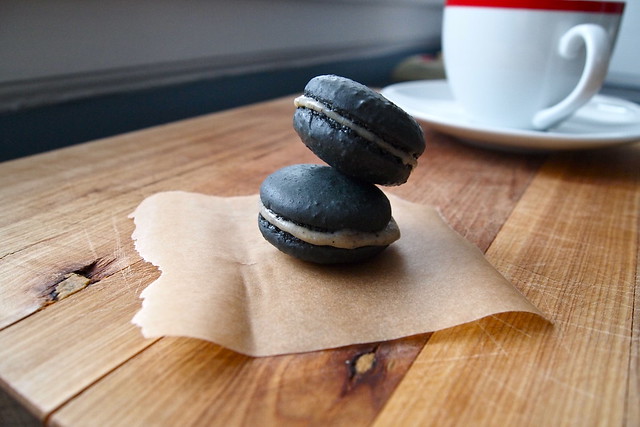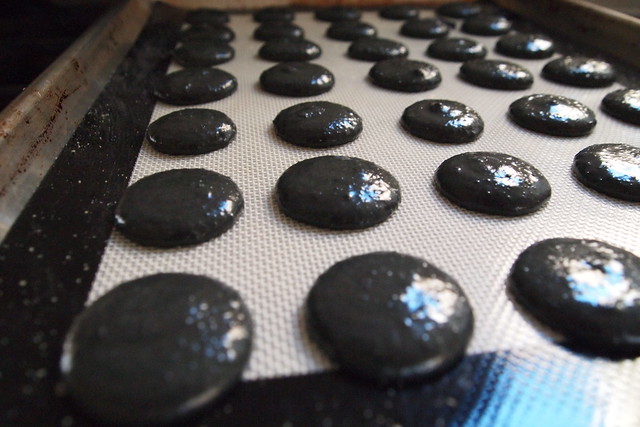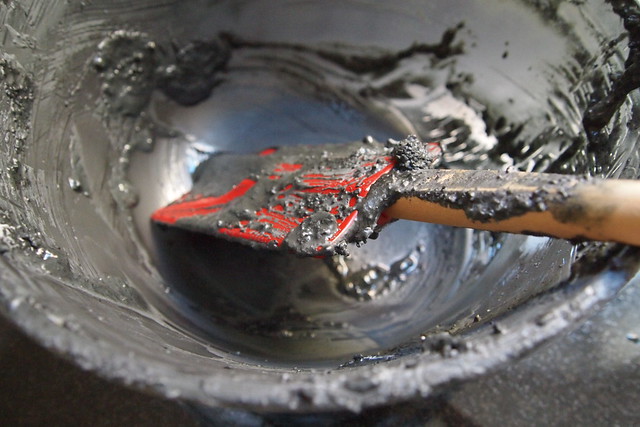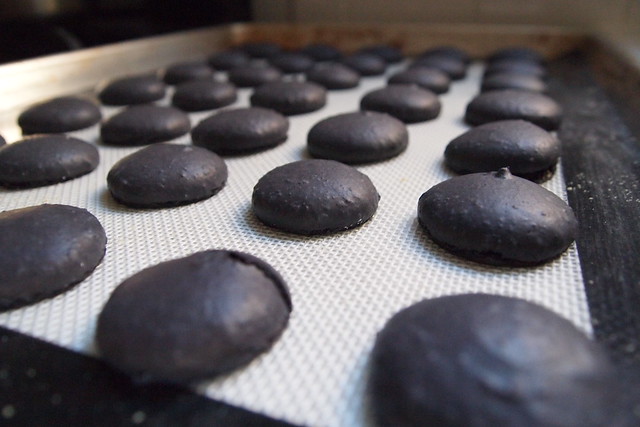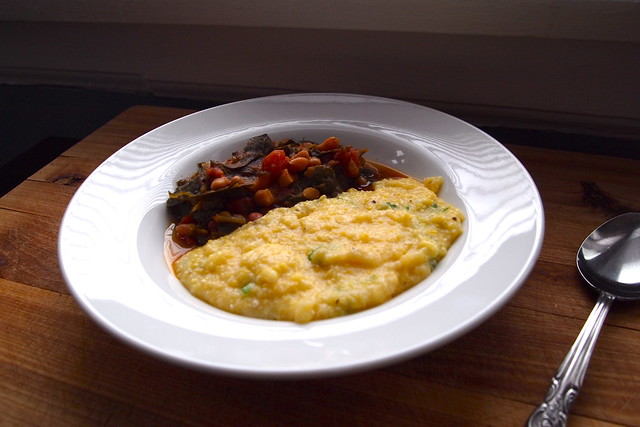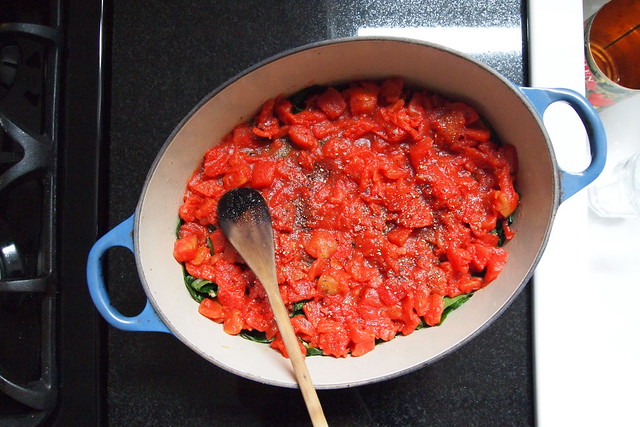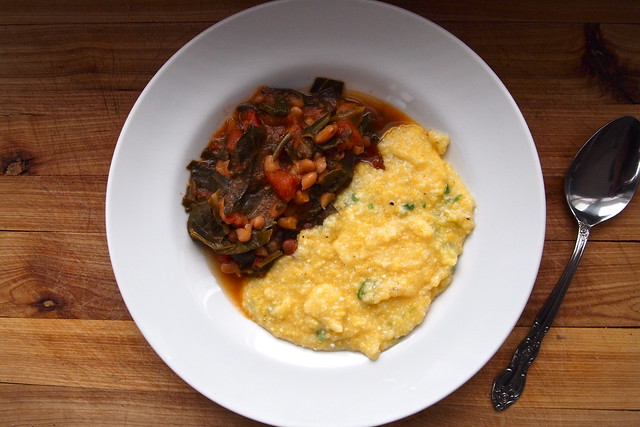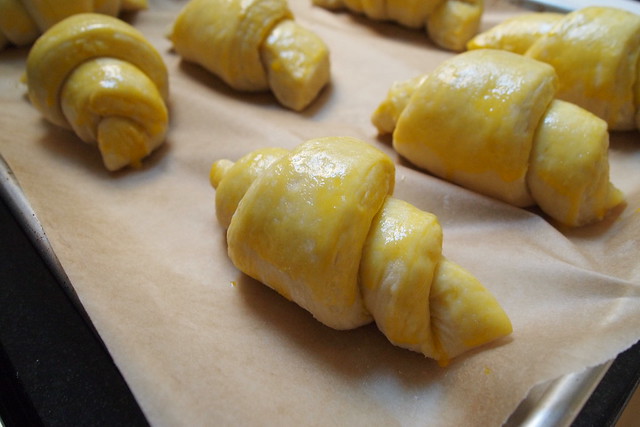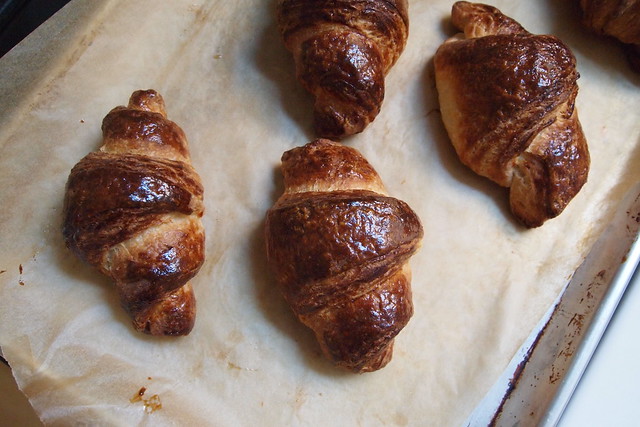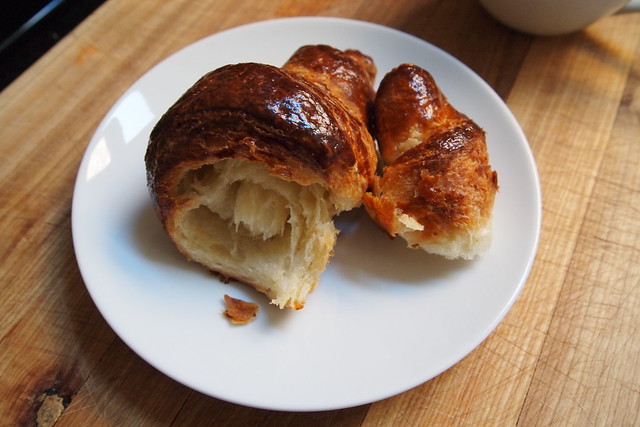My boyfriend, Octavian (yes, he has a name!), has a knack for fixing things. Mostly, he tinkers with vintage audio parts, but he's pretty handy with a hammer or a hacksaw too. It's not too uncommon to find him over at a friend's putting something back into working order or assembling something new. Most recently, he's been helping some friends of ours re-arrange their kitchen's layout--basically, breaking down a cluster of wall cabinets and converting them into serviceable base cabinets (hooray for more counter space!). The job's almost done, and it's looking great. Though this sort of thing is just what Octavian likes to do in his spare time, our friends wanted to thank him for his help. So, late last week, they put together the most wonderful box of gourmet goodies for us. Quail eggs! Foie gras! A bottle of summer truffles! It was like Christmas.
I was more than a little giddy, but I wanted to play with something straightaway, jump right into that sandbox. It was hard to know where to start. Quail eggs first? Or truffles? Or both? I'd never worked with (or tasted, in fact) either before. So, I started a little research, thinking I'd carefully weigh my options. But then it hit me: Hermé has a recipe for black truffle macarons; I have a bottle of truffles. Conclusion: I have to make truffle macarons.
Now, I still don't know that much about truffles, but I can tell you this. The black truffles you've probably heard of--the ones that can go for $100 or more apiece fresh--are Périgord truffles (Tuber melanosporum) and come mostly from the south of France. These, I'm told, are the mother of all black truffles, the most fragrant and flavourful of the lot. They're available late in the fall through early winter and go for something like €1000 per kilo (that's just over two pounds) at farmers' markets. Unsurprisingly, it's some of these that Hermé expects you to be able to get your hands on for the macarons. All I have to say to that is: yeah right.
My truffles were summer truffles (Tuber aestivum), which, apparently, are a good second to the Périgord (like Robin to the Périgord's Batman?). And though these in particular were bottled (a lot of people, it seems, have been disappointed by bottled truffles, i.e. have found them to be completely flavourless), my friends and I thought that they were extraordinary--wildly deep, earthy, and aromatic, unlike any other mushroom we'd ever had. Bottled truffles might not compare to fresh specimens (again, I'm not in a position to say), but I was more than happy with these.
Oh, and if you're balking at the thought of mushrooms and white chocolate together...well, I did too. In fact, I was pretty convinced mid-way through the process that the macarons were going to be abhorrent, a terrible waste of truffles. But Hermé proved me wrong. Black truffles make for an incredible macaron. Somehow, all that milky sweetness just works with them. Their mushroomy earthiness blooms out of it and leaves you a little bewildered, a little awestruck. These macarons are unexpectedly marvellous. Hermé does it again.
Summer Truffle Ganache
Adapted from Pierre Hermé's Macaron
Note: About the truffles. Truffles are sold in a number of ways--fresh, frozen, bottled, and canned. I can't speak to the differences between them, but I'll say a little about the bottled variety. People tend to be disappointed with bottled truffles, and maybe it's warranted, but it might also have to do with the fact that the bottled ones lose their aroma especially quickly (or so I'm told). One place suggested that you add them immediately to whatever you're planning to cook them with and leave them in an air-tight container for a few hours to lock in their aroma. That's what I ended up doing--I chopped up my truffles, added them to the heavy cream, and let them sit together overnight. Of course, people also warn you not to overheat truffles and advise adding them at the end of cooking, which you can't do here if you've already added them to the cream. So, I don't have anything conclusive to say on the matter, only that I didn't note any serious loss of flavour after bringing the cream to a boil. One last thing--I left the ganache piping to Octavian, and he reported having some trouble keeping the ganache the right consistency. It warmed up very quickly in the pastry bag and made for some very sloppy-looking macarons. He even gave it a few minutes in the freezer when it got really runny. I don't know what to make of this. I added the little bit of truffle juice from the bottom of the bottle to the heavy cream before boiling. I don't know what effect that had. It might have just been an execution problem with the ganache. Macaron shells. For these macarons, I made some pretty standard Hermé Italian-meringue shells done up with 7 g or so of black gel food colouring. You can get a sense for them here. If their feet don't look particularly impressive, it's because I didn't check my new oven's temperature settings against any thermometer readings. From the looks of the shells, my oven's burning a little on the cool side.
175 g heavy cream
35 g summer truffles (see notes above)
219 g good quality white chocolate, finely chopped
Put the chopped chocolate in a heat-proof bowl over a pot of simmering water to melt. Stir occasionally.
Bring the cream to a boil. Chop the truffles finely. Add the truffles to the cream and mix with an immersion blender or in a blender until smooth, about 2 minutes. The truffle pieces will still be visible. Pour the cream in three rounds over the melted chocolate, stirring with each addition. Pour the ganache into a wide, shallow dish and cover with plastic wrap, touching it to the surface of the ganache. Chill in the refrigerator until thick and creamy, 3-4 hours.
Makes enough ganache for 36 macarons.
P.S. Has anyone ever tried the black truffles grown in Oregon? Though they're still expensive, they aren't prohibitively priced like the Périgords. And from what I've read, some people really like them. I'm tempted to order just enough for another batch of macarons while they're still in season. Can anyone recommend a vendor?
P.P.S. An English translation of Pierre Hermé's classic book, Macaron, was just released at the end of 2011 in North America, so now, you don't have to beg a friend going to Paris to scour the city for a copy and then struggle with your grade-school French translating recipes. I hear that the translation isn't great but still passable.
I was more than a little giddy, but I wanted to play with something straightaway, jump right into that sandbox. It was hard to know where to start. Quail eggs first? Or truffles? Or both? I'd never worked with (or tasted, in fact) either before. So, I started a little research, thinking I'd carefully weigh my options. But then it hit me: Hermé has a recipe for black truffle macarons; I have a bottle of truffles. Conclusion: I have to make truffle macarons.
Now, I still don't know that much about truffles, but I can tell you this. The black truffles you've probably heard of--the ones that can go for $100 or more apiece fresh--are Périgord truffles (Tuber melanosporum) and come mostly from the south of France. These, I'm told, are the mother of all black truffles, the most fragrant and flavourful of the lot. They're available late in the fall through early winter and go for something like €1000 per kilo (that's just over two pounds) at farmers' markets. Unsurprisingly, it's some of these that Hermé expects you to be able to get your hands on for the macarons. All I have to say to that is: yeah right.
My truffles were summer truffles (Tuber aestivum), which, apparently, are a good second to the Périgord (like Robin to the Périgord's Batman?). And though these in particular were bottled (a lot of people, it seems, have been disappointed by bottled truffles, i.e. have found them to be completely flavourless), my friends and I thought that they were extraordinary--wildly deep, earthy, and aromatic, unlike any other mushroom we'd ever had. Bottled truffles might not compare to fresh specimens (again, I'm not in a position to say), but I was more than happy with these.
Oh, and if you're balking at the thought of mushrooms and white chocolate together...well, I did too. In fact, I was pretty convinced mid-way through the process that the macarons were going to be abhorrent, a terrible waste of truffles. But Hermé proved me wrong. Black truffles make for an incredible macaron. Somehow, all that milky sweetness just works with them. Their mushroomy earthiness blooms out of it and leaves you a little bewildered, a little awestruck. These macarons are unexpectedly marvellous. Hermé does it again.
Summer Truffle Ganache
Adapted from Pierre Hermé's Macaron
Note: About the truffles. Truffles are sold in a number of ways--fresh, frozen, bottled, and canned. I can't speak to the differences between them, but I'll say a little about the bottled variety. People tend to be disappointed with bottled truffles, and maybe it's warranted, but it might also have to do with the fact that the bottled ones lose their aroma especially quickly (or so I'm told). One place suggested that you add them immediately to whatever you're planning to cook them with and leave them in an air-tight container for a few hours to lock in their aroma. That's what I ended up doing--I chopped up my truffles, added them to the heavy cream, and let them sit together overnight. Of course, people also warn you not to overheat truffles and advise adding them at the end of cooking, which you can't do here if you've already added them to the cream. So, I don't have anything conclusive to say on the matter, only that I didn't note any serious loss of flavour after bringing the cream to a boil. One last thing--I left the ganache piping to Octavian, and he reported having some trouble keeping the ganache the right consistency. It warmed up very quickly in the pastry bag and made for some very sloppy-looking macarons. He even gave it a few minutes in the freezer when it got really runny. I don't know what to make of this. I added the little bit of truffle juice from the bottom of the bottle to the heavy cream before boiling. I don't know what effect that had. It might have just been an execution problem with the ganache. Macaron shells. For these macarons, I made some pretty standard Hermé Italian-meringue shells done up with 7 g or so of black gel food colouring. You can get a sense for them here. If their feet don't look particularly impressive, it's because I didn't check my new oven's temperature settings against any thermometer readings. From the looks of the shells, my oven's burning a little on the cool side.
175 g heavy cream
35 g summer truffles (see notes above)
219 g good quality white chocolate, finely chopped
Put the chopped chocolate in a heat-proof bowl over a pot of simmering water to melt. Stir occasionally.
Bring the cream to a boil. Chop the truffles finely. Add the truffles to the cream and mix with an immersion blender or in a blender until smooth, about 2 minutes. The truffle pieces will still be visible. Pour the cream in three rounds over the melted chocolate, stirring with each addition. Pour the ganache into a wide, shallow dish and cover with plastic wrap, touching it to the surface of the ganache. Chill in the refrigerator until thick and creamy, 3-4 hours.
Makes enough ganache for 36 macarons.
P.S. Has anyone ever tried the black truffles grown in Oregon? Though they're still expensive, they aren't prohibitively priced like the Périgords. And from what I've read, some people really like them. I'm tempted to order just enough for another batch of macarons while they're still in season. Can anyone recommend a vendor?
P.P.S. An English translation of Pierre Hermé's classic book, Macaron, was just released at the end of 2011 in North America, so now, you don't have to beg a friend going to Paris to scour the city for a copy and then struggle with your grade-school French translating recipes. I hear that the translation isn't great but still passable.

